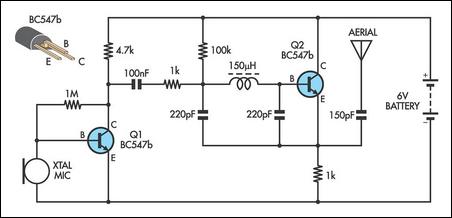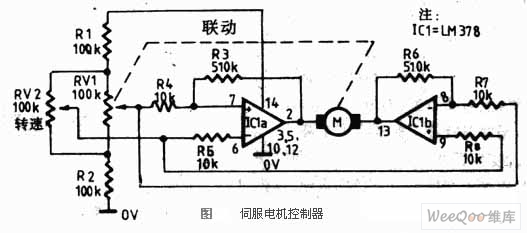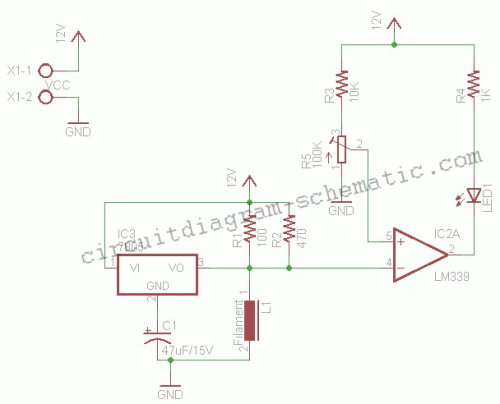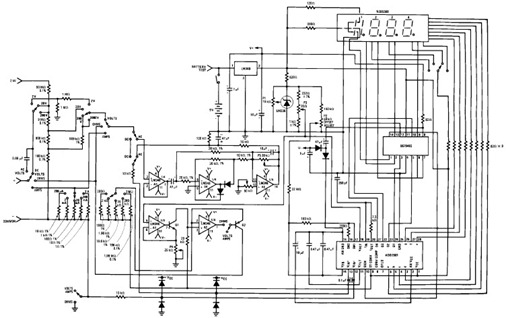
Simple AM Transmitter

This AM transmitter is notably simple to construct due to its design, which features a non-tapped inductor with a single winding. The inductor is not custom-wound, as it can be sourced from readily available RF chokes, such as the Jaycar Cat LF-1536. To minimize the circuit size, conventional tuning capacitors have been replaced with fixed 220pF capacitors. To achieve tuning to a specific frequency, one or both of the 220pF capacitors can be reduced to increase the frequency, or additional capacitance can be added in parallel to decrease the frequency. The transistor Q1 is biased with a 1MΩ resistor, providing high input impedance, which enables the use of a crystal earpiece as an economical microphone.
This AM transmitter circuit is designed for ease of assembly and compactness. The choice of a single-winding inductor simplifies the construction process, eliminating the complexity associated with tapped inductors. The RF choke utilized serves not only as an inductor but also ensures that the circuit operates efficiently within the radio frequency range. The fixed capacitors are chosen to streamline the design, reducing the number of components and the overall size of the circuit board.
Tuning the transmitter to a desired frequency is facilitated by the adjustable capacitance method. By altering the values of the fixed capacitors, the operating frequency can be finely tuned. This design choice allows for flexibility in tuning while maintaining a compact form factor. The high input impedance provided by the biasing resistor allows for the effective use of low-cost audio input devices, such as crystal earpieces, making this circuit accessible for hobbyists and educational purposes alike.
The circuit may include additional components such as a power supply, which should be carefully selected to match the voltage and current requirements of the transistor. Proper grounding and shielding techniques should also be employed to minimize interference and enhance the performance of the transmitter. Overall, this AM transmitter design represents a practical solution for those interested in radio transmission and electronics experimentation.There are not many AM transmitters that are easier to build than this one because the inductor is not tapped and has a single winding. There is no need to wind the inductor as it is a readily available RF choke (eg, Jaycar Cat LF-1536).
To make the circuit as small as possible, the conventional tuning capacitor has been dispensed with and fixed 22 0pF capacitors used instead. To tune it to a particular frequency, reduce one or both of the 220pF capacitors to raise the frequency or add capacitance in parallel to lower the frequency. Q1 is biased with a 1MO resistor to give a high input impedance and this allows the use of a crystal ear piece as a low cost microphone.
🔗 External reference
This AM transmitter circuit is designed for ease of assembly and compactness. The choice of a single-winding inductor simplifies the construction process, eliminating the complexity associated with tapped inductors. The RF choke utilized serves not only as an inductor but also ensures that the circuit operates efficiently within the radio frequency range. The fixed capacitors are chosen to streamline the design, reducing the number of components and the overall size of the circuit board.
Tuning the transmitter to a desired frequency is facilitated by the adjustable capacitance method. By altering the values of the fixed capacitors, the operating frequency can be finely tuned. This design choice allows for flexibility in tuning while maintaining a compact form factor. The high input impedance provided by the biasing resistor allows for the effective use of low-cost audio input devices, such as crystal earpieces, making this circuit accessible for hobbyists and educational purposes alike.
The circuit may include additional components such as a power supply, which should be carefully selected to match the voltage and current requirements of the transistor. Proper grounding and shielding techniques should also be employed to minimize interference and enhance the performance of the transmitter. Overall, this AM transmitter design represents a practical solution for those interested in radio transmission and electronics experimentation.There are not many AM transmitters that are easier to build than this one because the inductor is not tapped and has a single winding. There is no need to wind the inductor as it is a readily available RF choke (eg, Jaycar Cat LF-1536).
To make the circuit as small as possible, the conventional tuning capacitor has been dispensed with and fixed 22 0pF capacitors used instead. To tune it to a particular frequency, reduce one or both of the 220pF capacitors to raise the frequency or add capacitance in parallel to lower the frequency. Q1 is biased with a 1MO resistor to give a high input impedance and this allows the use of a crystal ear piece as a low cost microphone.
🔗 External reference
Warning: include(partials/cookie-banner.php): Failed to open stream: Permission denied in /var/www/html/nextgr/view-circuit.php on line 713
Warning: include(): Failed opening 'partials/cookie-banner.php' for inclusion (include_path='.:/usr/share/php') in /var/www/html/nextgr/view-circuit.php on line 713





